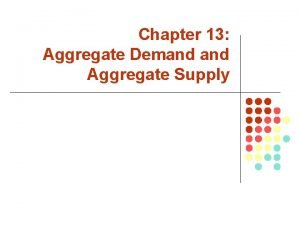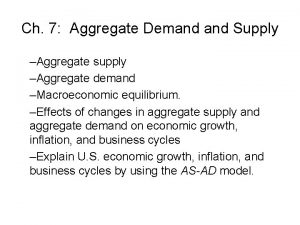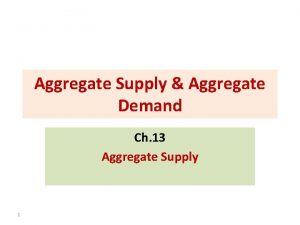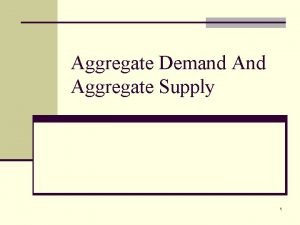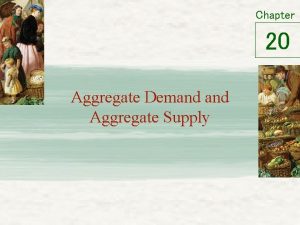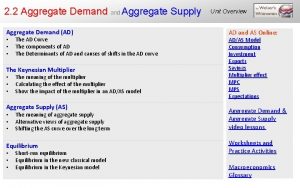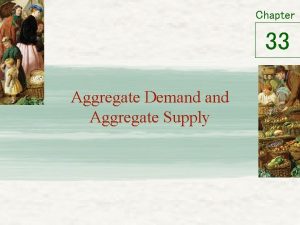LECTURE 3 Aggregate Demand Aggregate Supply Aggregate Demand














- Slides: 14

LECTURE 3 Aggregate Demand & Aggregate Supply

Aggregate Demand • Aggregate demand is a schedule or curve that shows the amounts of real output that buyers collectively desire to purchase at each possible price level.

Aggregate Demand Curve Price Level AD GDP

Why is the Aggregate Demand Curve Downward Sloping? Real-Balances Effect Interest-Rate Effect Foreign Purchases Effect

• Real-Balances Effect (a) A higher price level reduces the real value or purchasing power of the public’s accumulated savings balances. (b) Real value of assets with fixed money values (eg. savings accounts, bonds etc. ) diminishes. (c) As a result, the public is poorer in real terms and will reduce spending.

• Interest-Rate Effect (a) Assume that the supply of money in the economy is fixed. (b) When price level rises, consumers and businesses need more money. (c) So, given a fixed money supply, an increase in money demand will drive up the price paid for its use. The price is the interest rate. (d) Higher interest rate curtail investment spending and interest-sensitive consumption spending. (e) By increasing the demand for money, and consequently the interest rate, a higher price level reduces the amount of real output demanded.

• Foreign Purchases Effect (a) When the Malaysian price level rises relative to foreign price levels (and exchange rates do not respond quickly or completely), foreigners buy fewer Malaysian goods and Malaysians buy more foreign goods. (b) Therefore, Malaysian exports fall and Malaysian imports rise. (c) In short, rise in the price level reduces the quantity of Malaysian goods demanded as net exports.

Determinants of Aggregate Demand 1. Consumer Spending (a) Consumer wealth (b) Consumer expectations (c) Household indebtedness 2. Investment Spending (a) Real interest rate (b) Expected returns

3. Government Spending 4. Net Export Spending (a) National income abroad (b) Exchange rates

Aggregate Supply • Aggregate supply is a schedule or curve showing the level of real domestic output that firms will produce at each price level.

Aggregate Supply Curve • There are two types of aggregate supply curve; which are in the long run and short run. Long Run Short Run Price Level AS GDP

Aggregate Supply in the Long Run • When changes in wages respond completely to changes in the price level, those price-level changes do not alter the amount of real GDP produced and offered for sale. • The long-run aggregate supply curve is vertical at the economy’s potential output (or full –employment output).

Aggregate Supply in the Short Run • Price-level declines reduce real profits and cause firms collectively to reduce their output. • So, in the short run, there is a direct or positive relationship between the price level and real output.

Determinants of Aggregate Supply • Input Prices (a) Domestic resource prices (b) Prices of imported resources (c) Market power • Legal-Institutional Environment (a) Business taxes and subsidies (b) Government regulation
 Unit 3 aggregate demand aggregate supply and fiscal policy
Unit 3 aggregate demand aggregate supply and fiscal policy Shift in sras curve
Shift in sras curve Unit 3 aggregate demand aggregate supply and fiscal policy
Unit 3 aggregate demand aggregate supply and fiscal policy Aggregate demand and aggregate supply
Aggregate demand and aggregate supply Unit 3 aggregate demand aggregate supply and fiscal policy
Unit 3 aggregate demand aggregate supply and fiscal policy Aggregate supply shifters
Aggregate supply shifters Aggregate supply and demand graph
Aggregate supply and demand graph Disaggregate planning
Disaggregate planning Ad as
Ad as Matching supply and demand in supply chain
Matching supply and demand in supply chain Module 5 supply and demand introduction and demand
Module 5 supply and demand introduction and demand 01:640:244 lecture notes - lecture 15: plat, idah, farad
01:640:244 lecture notes - lecture 15: plat, idah, farad Tableau cannot mix aggregate and non aggregate
Tableau cannot mix aggregate and non aggregate Switch mode power supply lecture notes
Switch mode power supply lecture notes Aggregate supply shifters
Aggregate supply shifters














